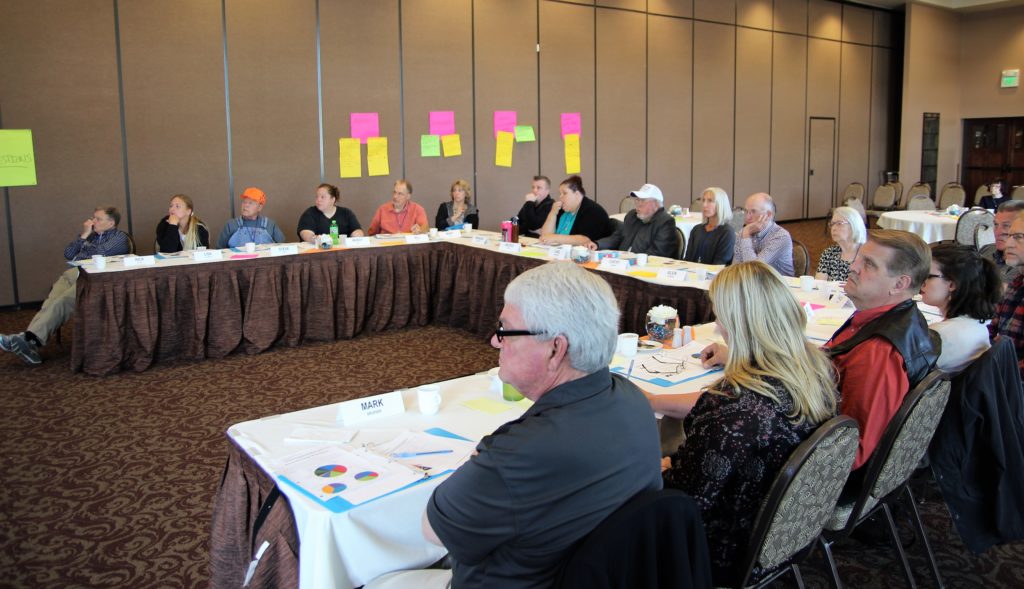On May 18-19, 2018, a diverse group of 18 Itasca County community members gathered to learn about their local energy system, and make recommendations on ways it could be improved.
Over the two days, participants studied the energy system in detail, assessed criteria for evaluating the energy system, identified challenges and opportunities related to the energy system in Itasca County, and created action plans to help address challenges and realize opportunities.
Below you’ll find a summary of the discussion. To dive deeper, download the event report.
Energy System Criteria
Participants identified four criteria of a productive energy system, and why those criteria may be important to residents of Itasca County.
Reliability
Reliability is important because:
- We need to be able to depend on our power, especially during cold winters, hot summers, and other extreme events.
- A modern society and a functional economy are not possible without a constant source of energy.
- The health, well-being, and safety of Itasca County residents depends on access to energy.
- We do not have adequate backups.
Affordability
Affordability is important because:
- People need to be able to afford enough basic electricity to meet basic needs.
- Disparity of prices of different power companies.
- Fixed incomes aren’t flexible and are more impacted by rising energy costs.
- We can’t choose and are dependent on the power company to control their costs.
Minimizing Pollution and/or Climate Change
Minimizing pollution and/or climate change is important because:
- Impact it has on our local environment, health, and quality of life.
- Impact it has on the sustainability of our global energy systems.
Supports Local Jobs and Local Investment
Supporting local jobs and local investment is important because:
- Helps the stability of the local economy with good paying jobs.
- Local ownership increases accountability and pride.
- To continue to support the local economy.
- Encourages local control.
Top Challenges
The following are the top challenges facing Itasca County’s energy system, as ranked by participants.
Energy Sources
- Back up energy storage is a challenge because technology is lacking. (29pts)
- The intermittent nature of renewable resources is a challenge because timing of energy production may not match demand. (25pts)
- Maintaining a diverse energy portfolio (coal, natural gas, wind, solar, nuclear, hydro) is a challenge because the carbon-constrained environment is changing the balance of available options. (25pts)
- Balancing production versus load is a challenge to lower the cost for the end user. (13pts)
- Government regulations are a challenge because they should keep costs down and allow companies to be more flexibility. (9pts)
- Keeping current assets competitive and responsive is a challenge because non-responsive units may not make it to the market based on price. (1pt)
Local Utilities
- Replacement of aging infrastructure is a challenge because electricity demand is not
growing. (29pts) - Maintaining a reliable system without excessively burdening customers is a challenge because affordability is important. (25pts)
- The cost and availability of renewable resources is a challenge because it must be affordable for the end user. (19pts)
- Maintaining a fair rate structure is a challenge because of different user groups. (9pts)
- Maintain rate fairness is a challenge because we are locked into a certain utility. (8pts)
- Balancing the interests and involvement of the general public and the utilities is a challenge because we need to protect the interests of the general public. (8pts)
- Managing a 2-way power flow is a challenge as more people produce their own electricity. (7pts)
Consumer Impacts
- Replacement of aging infrastructure is a challenge because electricity demand is not
growing. (29pts) - Educating consumers in how energy usage affects peak demand is a challenge because
an educated consumer can have a positive effect in reducing costs. (44pts) - Creating incentives to motivate the consumer to conserve more or control peak demands is a challenge because people may not act without incentives. (24pts)
- Reducing peak energy demand is a challenge because people can’t afford the high rates. (20pts)
- Maintaining rate fairness is a challenge because people need to pay for their usage accordingly. (17pts)
- Big business being billed on a 15-minute peak demand is a challenge because it affects the whole month’s bill (3pts).
Top Opportunities
Here are the top energy opportunities in Itasca County, as ranked by participants.
Energy Sources
- Education of the general public and community dialogue are necessary to affect long term
improvements. (33pts) - Developing bio-fuel technologies is an opportunity, especially in Itasca County, because we have the resources here and it would enhance the local economy. (21pts)
- There will be more opportunities for new energy generation resources because storage technologies will be developed. (17pts)
- Maintaining diversity in resources is a challenge because cost and reliability are important. (14pts)
- As newer renewable technologies become more common, the relative costs will come down, which is important because we want to maintain affordability. (13pts)
- Working towards more flexible generation units is an opportunity because that allows energy generation units to run in more flexible periods. (6pts)
Local Utilities
- As smart grid and other new distribution level technologies are developed, implemented, and improved, better educated customers can manage their resources more effectively. (38pts)
- The decreasing costs of renewables will lead to more investment in them because it will be more cost effective. (21pts)
- Education is an opportunity because the more we know the better decisions we make. (20pts)
- End users having more energy efficient devices/advanced technology is an opportunity to decrease consumption. (14pts)
- The global market of energy provides more options to the consumer and utilities. (7pts)
- Carbon reduction is best accomplished with large partner collaboration between power generation companies because we need to reduce our reliability on carbon fuels. (6pts)
Consumer Impacts
- Incentives for more efficient use of energy are opportunities because they benefit the individual users as well as the utilities. (34pts)
- Educating consumers in how energy usage affects peak demand is a challenge because an educated consumer can have a positive effect in reducing costs.(44pts)
- Commercial load management is an opportunity because lowering peak energy demand saves everyone money. (19pts)
- Residential load management is an opportunity because being aware of your energy usage is important. (14pts)
- There are new technologies that are becoming available that will help consumers reduce usage and peak demands. (11pts)
- The increasing cost of energy drives innovations and new technologies which can lead to more cost-efficient options. (4pts)



